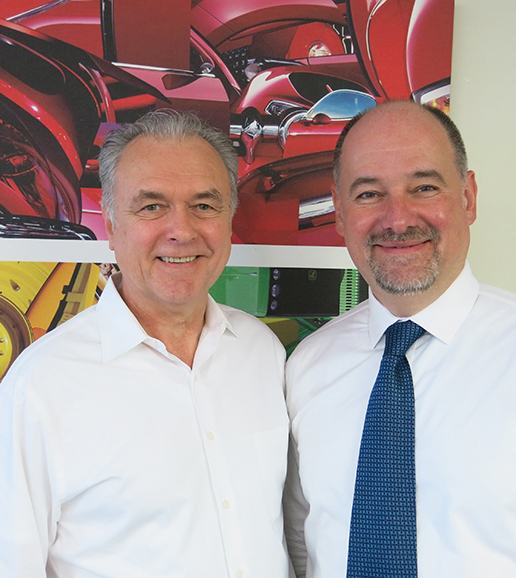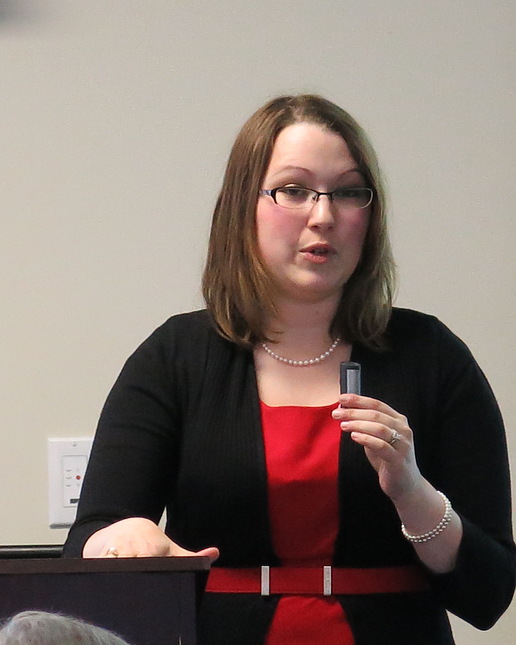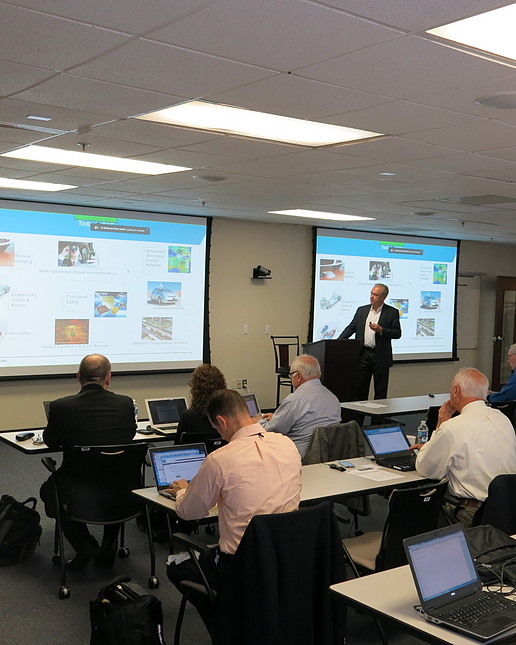 SAE International的行业标准专家Jack Pokrzywa(左)与IEEE的Oleg Logvinov为最近举办的物联网研讨会担任主持。
SAE International的行业标准专家Jack Pokrzywa(左)与IEEE的Oleg Logvinov为最近举办的物联网研讨会担任主持。 SAE本体论工程师Ashleigh Faith表示,给予SME技术的schema语言是信息检索的重要组成部分,而信息检索又是开发物联网标准所必需的。
SAE本体论工程师Ashleigh Faith表示,给予SME技术的schema语言是信息检索的重要组成部分,而信息检索又是开发物联网标准所必需的。 由SAE与IEEE共同主办的物联网研讨会共有150名工程师和技术专家出席
由SAE与IEEE共同主办的物联网研讨会共有150名工程师和技术专家出席
SAE International和国际电气与电子工程师学会(IEEE)正在联合开发一个与迅速崛起的物联网(IoT)有关的标准框架。这些数以亿计、互相连接的“智能”设备,不仅能改善我们的日常生活,而且已经对汽车、生产、用户体验和技术创新等领域产生了重大影响。
SAE International和IEEE在5月7日联合举办了一场研讨会,讨论目前正在开发的IEEE P2413标准,该标准旨在为IoT提供一个坚实的结构性框架和多方平台。来自汽车行业和其他行业的约150名工程师参加了这场在SAE密苏里州特洛伊办公室举办的会议。会议全面介绍了IEEE的物联网举措以及与之相关的SAE项目,来自南加州大学法学院的副教授Bryant Walker Smith通过WebEx和与会者探讨了物联网的法律与责任议题。
许多工程师认为,物联网行业标准的缺失,不仅阻碍了互操作性的实现,而且使得针对网络安全等重要国际问题的技术解决方案也迟迟不能发展。IEEE从2012年开始着手物联网项目,并于2014年成立了IEEE P2413标准工作小组。凭借着在汽车、航空航天与商业汽车等领域的深厚技术背景,SAE成为了IEEE所寻求的理想合作伙伴。这两家机构在各自行业中坚持中立,且注重行业共识的达成,这样的决策理念使他们在全球范围内广受尊敬。
Oleg Logvinov 是IEEE P2413工作小组主席,同时也是意法半导体公司工业与能量转换部门特殊任务部的主管。他表示,IEEE计划在2016年下半年发布该结构框架标准的第一版。
“近期开展的SAE-IEEE研讨会,是我们主动参与汽车行业物联网要求与标准制定的一系列举措的开始. ”SAE地面车辆标准主管Jack Pokrzywa表示。
Jack认为汽车行业“不应错失良机,必须尽快走上物联网之路,并与其他行业携手寻找共同的解决方案。”这些方案不仅能提高汽车的安全性和可靠性,改善用户体验,而且还能为制造商和服务供应商带来全新的盈利机会。
Logvinov将物联网形容为“一个呈现出许多方面特点的巨大课题,就像那个著名的‘房间里的大象’一样。”他认为,IEEE与SAE的合作“可以充分发挥双方的专业技能,并为工程师创造出真正有价值的东西。这一标准将体现出SAE以及电信服务商、工业企业与其他机构在相关领域中所做的努力。”
对那些正在开发汽车系统中的V2V、V2G和其他相关技术的机构来说,IEEE P2413结构框架“提供的‘蓝图’可以通过一种安全可靠的方式将一切事物整合起来,从而简化他们的工作,” Logvinov指出。“如果这项任务真的可以达成,我认为这将是一项伟大的成就。”
若想了解IEE P2413的更多信息,请登录IEEE标准协会官方网站,并阅读《物联网结果框架起草标准》(Draft Standard for an Architectural Framework for the Internet of Things (IoT))。
网站链接:http://standards.ieee.org/develop/project/2413.html
5月7日研讨会的参会嘉宾已表达出积极参与该项工作的意愿。目前各方正在准备成立一个战略指导委员会,处理相关事宜。如果您希望随时了解最新进展,并参与这一工作,请接洽IoT@sae.org或点击LinkedIn链接 https://www.linkedin.com/grp/home?gid=8304079。
开发强有力的物联网标准的一大关键要素是schema语言——数字消费信息的标记流程。最常见的例子就是XML,这是定义了一系列编码规则的一种标记语言,按这种规则编码的文件,人类和电脑都能阅读。“但也有一些schema语言是用于信息检索的,而这些就是物联网所需要的语言,”领导SAE拓补学与知识管理项目的本体论工程师Ashleigh Faith解释说。
SAE的尖端技术数据库及其广而精的“领域专家”(SME)“可为schema语言的标准化、规范化和筹划布局提供丰富的专业数据,” Faith表示。Faith是匹茨堡大学博士研究生,曾与北约、NASA、卡特彼勒与迪尔等公司开展过schema合作项目。
她补充道,如果schema语言中不加入智能科技,那么“物联网的前景就会像互联网在上世纪九十年代所面临的境况一样,尽管是充满希望的技术,但却缺乏进一步发展所需的载体。”
SAE and IEEE join forces to explore potential IoT standards
SAE International and IEEE are jointly exploring a standards framework related to the rapidly emerging Internet of Things (IoT)—the billions of interconnected “smart” devices that enhance our daily lives and are already impacting vehicle development, manufacturing, the customer experience, and technology innovation.
The organizations hosted a workshop May 7 to discuss IEEE P2413, a standard currently under development that is aimed at providing a robust architectural framework and multi-stakeholder platform for the IoT. About 150 engineers from the mobility and other industries attended the workshop, held at SAE’s Troy, MI, office. Topics included overviews of IEEE’s IoT initiative and relevant SAE projects. Legal/liability aspects of the IoT were covered by Bryant Walker Smith, Assistant Professor at the University of South Carolina Law School, who spoke via WebEx.
Many engineers view the absence of IoT standards as a hurdle for achieving interoperability and finding technical solutions for critical global issues such as cybersecurity. IEEE began its IoT activities in 2012 and formed a working group for the IEEE P2413 project in 2014. They looked to SAE for the technical depth of its membership in the automotive, aerospace, and commercial vehicle sectors. Both organizations are globally respected for their neutral, consensus-based decision making within the industries they serve.
IEEE plans to have the first version of the architectural framework standard published in late 2016, said Oleg Logvinov, Chair of the IEEE P2413 Working Group and Director of Special Assignments, Industrial and Power Conversion Div., atSTMicroelectronics.
The recent SAE-IEEE workshop “is the first of many steps to actively engage the automotive industry in developing applicable IoT requirements and standards,” said Jack Pokrzywa, SAE’s Director of Ground Vehicle Standards.
He said the mobility industry “cannot afford to miss the opportunity to get on board quickly and work with other sectors toward common solutions” aimed at increasing vehicle safety and reliability, improving the user experience, and exposing new revenue streams for manufacturers and service providers.
Logvinov described the IoT as “a huge, multifaceted subject—like the ‘elephant in the room.’” He said IEEE wanted to partner with SAE “in order to summon the domain expertise of both organizations and create something that has value for engineers. This standard would have to be cognizant of what SAE is doing in these areas, as well as what telecom providers, industrial companies, and others are doing,” he said.
For those developing V2V, V2G, and related technologies within vehicle systems, the IEEE P2413 architectural framework “will hopefully simplify their jobs by creating a ‘blueprint’ for integrating everything together in a safe and secure fashion,” Logvinov noted. “If we can accomplish that, I would consider it a tremendous success.”
To learn more about IEEE P2413, “Draft Standard for an Architectural Framework for the Internet of Things (IoT),” visit the IEEE Standards Assoc. websitehttp://standards.ieee.org/develop/project/2413.html.
Qualified participants from the May 7 workshop have expressed their interest in becoming actively involved in this initiative. A strategic steering committee is being set up to guide the effort. To stay informed or get engaged in this effort, go toIoT@sae.org or connect via LinkedIn https://www.linkedin.com/grp/home?gid=8304079.
A vital “building block” for creating robust IoT standards is schema—the process for tagging information for digital consumption. A common example is XML—the markup language that defines a set of rules for encoding documents in a format that is readable both by humans and machines. “But there are also schemas that are used for information retrieval, and that’s what is needed in the application of the IoT,” explained Ashleigh Faith, an ontology engineer who leads SAE’s taxonomy and knowledge management activities.
SAE’s industry-leading technical database and its depth and breadth of subject-matter experts (SMEs) “can provide rich inputs for schema standardization, alignment, and mapping,” said Faith, a Ph.D candidate at the University of Pittsburgh who has worked on schema projects with NATO, NASA, Caterpillar, andDeere, among others.
She added that without adding intelligence through schema, “the IoT will be like the Internet was in the 1990s—a promising technology without a vehicle to drive it.”
等级
打分
- 2分
- 4分
- 6分
- 8分
- 10分
平均分
- 作者:Lindsay Brooke
- 行业:汽车
- 主题:
